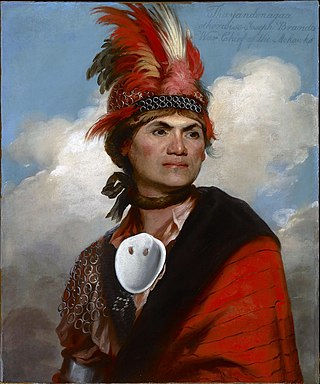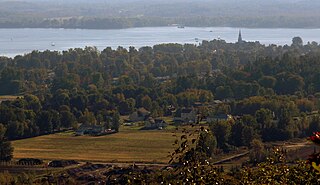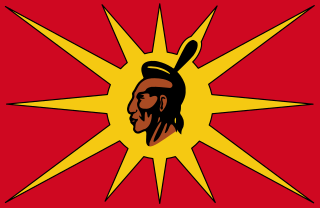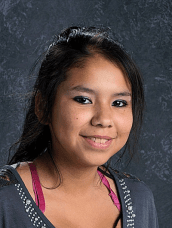
The Mohawk people are the most easterly section of the Haudenosaunee, or Iroquois Confederacy. They are an Iroquoian-speaking Indigenous people of North America, with communities in southeastern Canada and northern New York State, primarily around Lake Ontario and the St. Lawrence River. As one of the five original members of the Iroquois League, the Mohawk are known as the Keepers of the Eastern Door – the traditional guardians of the Iroquois Confederation against invasions from the east.
The Oka Crisis, also known as the Kanehsatà:ke Resistance, was a land dispute between a group of Mohawk people and the town of Oka, Quebec, Canada, which began on July 11, 1990, and lasted 78 days until September 26, 1990, with two fatalities. The dispute was the first well-publicized violent conflict between First Nations and provincial governments in the late 20th century.
Jerry Fontaine is an Anishinaabe politician in Manitoba, Canada. He was chief of the Sagkeeng First Nation from 1989 to 1998, led the First Peoples Party in the 1995 provincial election, and was an unsuccessful candidate to lead the Manitoba Liberal Party in 1998. He was the director of Indigenous Initiatives at Algoma University from 2004-2008.

The Kahnawake Mohawk Territory is a First Nations reserve of the Mohawks of Kahnawá:ke on the south shore of the Saint Lawrence River in Quebec, Canada, across from Montreal. Established by French Canadians in 1719 as a Jesuit mission, it has also been known as Seigneury Sault du St-Louis, and Caughnawaga. There are 17 European spelling variations of the Mohawk Kahnawake.

Larry Phillip Fontaine, is an Indigenous Canadian leader and former National Chief of the Assembly of First Nations. He best known for his central role in raising public awareness of the Canadian Indian residential school system and pushing to secure Federal and Papal apologies in 2008 and 2022 respectively. He also helped secure a repudiation of Discovery doctrine from Pope Francis on March 30, 2023.

Kanesatake is a Mohawk settlement on the shore of the Lake of Two Mountains in southwestern Quebec, Canada, at the confluence of the Ottawa and Saint Lawrence rivers and about 48 kilometres (30 mi) west of Montreal. People who reside in Kanehsatà:ke are referred to as Mohawks of Kanesatake. As of 2022, the total registered population was 2,751, with a total of about 1,364 persons living on the territory. Both they and the Mohawk of Kahnawake, Quebec, a reserve located south of the river from Montreal, also control and have hunting and fishing rights to Doncaster 17 Indian Reserve.

Alanis Obomsawin, is an Abenaki American-Canadian filmmaker, singer, artist, and activist primarily known for her documentary films. Born in New Hampshire, United States and raised primarily in Quebec, Canada, she has written and directed many National Film Board of Canada documentaries on First Nations issues. Obomsawin is a member of Film Fatales independent women filmmakers.

Oka is a small village on the northern bank of the Ottawa River, northwest of Montreal, Quebec, Canada. Located in the Laurentians valley on Lake of Two Mountains, where the Ottawa has its confluence with the St. Lawrence River, the town is connected via Quebec Route 344. It is located 50 km west of Montreal.

Peguis First Nation is the largest First Nations community in Manitoba, Canada, with a population of approximately 11,438 people. The members of Peguis are of Saulteaux (Ojibway) and Maškēkowak descent.
Bradford Lyttle is an American pacifist and peace activist. He was an organizer with the Committee for Non-Violent Action of several major campaigns against militarism, including "Omaha Action", against land-based nuclear missiles (1959) and "Polaris Action" against submarine-based nuclear missiles (1960). Lyttle and several others walked from San Francisco to New York City, and then through parts of Europe to Moscow, Russia, from December 1960 until late 1961. The action was called the San Francisco to Moscow March for Peace. Several participants, including Lyttle, walked the entire distance. He also walked in the Quebec-Washington-Guantanamo Peace Walk (1963).
Kanehsatake: 270 Years of Resistance is a 1993 feature-length film documentary film by Alanis Obomsawin, highlighting the events of the 1990 Oka Crisis. Obomsawin documents the events of The Siege of Kanehsatake over 78 days, capturing a rare perspective of an important turning point in Canadian history. Produced by the National Film Board of Canada, the film won 18 Canadian and international awards, including the Distinguished Documentary Achievement Award from the International Documentary Association and the CITY TV Award for Best Canadian Feature Film from the Toronto Festival of Festivals.
CKHQ-FM is a First Nations community radio station that operates at 101.7 FM in Kanesatake, Quebec, Canada.
Tracey Penelope Tekahentakwa Deer is a screenwriter, film director and newspaper publisher based in Kahnawake, Quebec. Deer has written and directed several award-winning documentaries for Rezolution Pictures, an Aboriginal-run film and television production company. In 2008, she was the first Mohawk woman to win a Gemini Award, for her documentary Club Native. Her TV series Mohawk Girls had five seasons from 2014 to 2017. She also founded her own production company for independent short work.
Joseph Tehwehron David (1957–2004) was a Mohawk artist who became known for his role as a warrior during the Oka Crisis in 1990.

The Rotisken’rakéhte, also known as the Mohawk Warrior Society and the Kahnawake Warrior Society, is a Mohawk group that seeks to assert Mohawk authority over their traditional lands, including the use of tactics such as roadblocks, evictions, and occupations.
Ellen Gabriel, also known as Katsi'tsakwas, is a Mohawk activist and artist from Kanehsatà:ke Nation – Turtle Clan, known for her involvement as the official spokesperson, chosen by the People of the Longhouse, during the Oka Crisis.

John Ciaccia was an Italian-born Canadian politician who was provincial cabinet minister from Montreal, Quebec. Ciaccia served as a member of the National Assembly of Quebec from 1973 to 1998, representing the Mount Royal riding for the Quebec Liberal Party. He occupied various posts in the cabinets of Liberal premiers Robert Bourassa, and Daniel Johnson Jr., such as minister of Energy and Natural Resources, International Affairs, Native Affairs, and Immigration and Cultural Communities. At his resignation, Ciaccia was the longest-serving member of the Assembly. Ciaccia gained international attention for his efforts in negotiating the end of the Oka Crisis alongside his federal counterpart, Tom Siddon, in 1990. Former Quebec Premier Jean Charest described Ciaccia's political career as having "revolutionized relations with the native people and cultural communities of Quebec by always favouring an approach marked by respect."

Tina Michelle Fontaine was a First Nations teenage girl who was reported missing and died in August 2014. Her case is considered among the high number of missing and murdered Indigenous women of Canada, and her death renewed calls by activists for the government to conduct a national inquiry into the issue.
Tammy Beauvais is an Indigenous fashion designer from Kahnawake Mohawk Territory in Quebec, Canada. She left Kahnawake in 1990 following the Oka Crisis. In 1999 Beauvais launched Tammy Beauvais Designs a North American Indigenous Fashion company which produces contemporary, authentically Indigenous made clothing that honors Indigenous spirituality and traditions.












